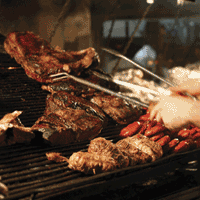Off the grill or out of the pit, summer means meat
Firing up the grill at the first hint of summer may be a great Canadian tradition, but today’s al fresco offerings are light years beyond the frozen patties and charred chicken with whichmany of us grew up. Fromsteak to chicken and fish to burgers galore, the summer season is a carnivore’s paradise.
At Allen’s in downtown Toronto, diners wait an hour for a seat at wooden tables on the saloon’s back patio, shaded by a century-old willow tree. Australian wagyu burgers, new this year, sizzle over Canadian hardwood charcoal ($19 with three salads), joining Henry Traynor’s local grass-fed steaks ($38-$44), wild Coho salmon ($29), ever-popular baby back ribs ($27) and freerange chicken ($24).
West on Highway 401 at the grand Langdon Hall, executive chef Jonathan Gushue is grilling up an international theme Friday nights by the lily pond for up to 200 hotel guests and locals from nearby Cambridge, Ont. Plans include nights in France, Italy, Argentina and Korea, with grill stations set up on the lawn for $65 per person. And, in Calgary, chef/owner John Jackson’s award-winning Charcut is taking meat to the street, roasting whole pigs curb-side on a rôtisserie and serving the meat inside as a special.
In burger belts like downtown Toronto, the demand for gourmet patties shows no sign of slowing, topped with a sky’s-the-limit choice of extras, from panko-crusted and deep-fried portobello mushrooms to Quebec foie gras. Craft Burger, where a 6-oz fully dressed classic burger starts at $5.35, now boasts three locations, while shoebox-sized Burger’s Priest enjoys a non-stop lineup for cash-only cheeseburgers that weigh in at just over $10 for a combo, including tax.
Burger barons agree the meat’s the thing. Tom Davis, owner of the Stockyards Smokehouse & Larder in mid-town Toronto, says he has a butcher grind brisket, chuck and a third cut he’d rather keep secret for his “griddle-smashed” burger ($7), which starts with a loose ball of meat flattened on a special chromeplated griddle to aid caramelization. “A lot of older people say our burgers remind them of when they were teenagers at mom and pop diners,” says Davis, “but we also get teenage boys coming in for double burgers.”
At Lovey’s BBQ & Smokehouse in Winnipeg, owner Roger LeBleu is proud of his Terminator burger — a seven-ounce U.S. certified angus patty (he visited theMassachusetts farm that raises the beef), rubbed with his own spice mix. The $12.95 über-burger is topped with four ounces of house-smoked pulled pork, onion rings, lettuce, tomato, onion, coleslaw and barbecue sauce.
And, at Pig BBQ Joint in Victoria, B.C., cooks are given free rein to create burger specials. “We’ve even topped our burgers with deep-fried mac and cheese,” says chef/owner Jeff Hetherington, who sees an additional burger joint or two in his future.
While most Canadians think of the iconic outdoor grill as barbecue, true barbecue, originating n the American South, has become a huge trend as chefs across the country load wood-fuelled smokers with primal cuts of pork and beef. The scrumptious esults are piling up on buns everywhere, from pubs to five-star dining rooms. Even Major League Soccer fans will be chowing down on smoked meat this summer as Maple Leaf Sports and Entertainment chefs give the Toronto FC’s 20,000 fans a taste of real pulled pork and brisket from its new smoker at the edge of BMO Field.
Many heroes of this red-hot revolution perfected their smoking skills at home. Take executive chef Anthony Rose of Toronto’s Drake Hotel, who opened the tiny Drake BBQ shop last fall. It’s powered by a pure wood smoker that holds 15 local pork shoulders or briskets and must be tended every hour. “A lot of people are doing barbecue, and it has exploded in NewYork,” says Rose, whose busiest time is 3 a.m. when the clubs close. “But you have to keep it authentic, low and slow, and not just cover the meat with a cloying sauce.”
A passion for barbecue convinced LeBleu, a retired Nike salesman, and pit boss and restaurant veteran Cindy Wheatley, owner of Boneheads BBQ in Halifax, to open their own places. Both fell in love with barbecue while visiting the smoke shacks below the Mason-Dixon, from Kansas to Texas and cutting a meaty swath east to North Carolina.
LeBleu, who sought advice from a U.S. pro and from pit master Eric Johnson of Smokin’ Okies BBQ in Regina, says business exploded” when he opened Winnipeg’s first “authentic” barbecue restaurant in 2008.He and his 25-year-old daughter opened a second Lovey’s nine months ago in a St. Boniface industrial park, partly because they needed more prep space. He loves to watch newcomers dig into his glistening ribs, cooked over Manitoba oak—$21.95 for a full slab, $16.95 for a half slab with beans, coleslaw, cornbread and potato salad or fries. “They take a bite, their eyes close and their head goes up and down as if to say, ‘Oh yes, this is it.’”
It’s simple pleasure, and that’s the point. “At a typical American barbecue place, you’re lucky to get a plate,” says Fred Konopaki, another backyard smoker who sold his fine-dining restaurant and opened the Palomino Smokehouse six years ago in downtown Calgary. “You might get waxed paper with pulled pork, a piece of white bread, a pickle and the sauce right on top,” Konopaki adds. “It’s as simple as it gets.”
His 150-seat room in a century-old brick building takes its cue from a “big-ass” Old Hickory pit, where 1,200 lbs of pork ribs (a “huge slab” is $24), Alberta beef brisket ($16) and pork shoulder for pulled pork ($16) are served with a choice of sides cook gently over Okanagan apple and cherry wood. Konopaki learned the tricks of the trade from a Nashville aster and says his business actually increased during the recession.
Ask any pit boss what’s hot this summer and the answer is pulled pork. “It’s the biggest trend in the world right now,” says Hetherington. Every restaurant has a pulled-pork sandwich on the menu, and some guys do an OK job. It’s no fluke that it’s happening because it’s a ‘set-it-and forget- it’ dish.”
Chefs at Pig BBQ Joint coat pork butts with a special rub and smoke them overnight for 11 hours over alder wood before pulling the tender meat apart by hand and steaming it gently before service. “You taste the smoke,” Hetherington says. “With BBQ sauce and vinegar slaw, it’s a pretty good sandwich.”
From there, anything goes, even barbecue spaghetti, which Pig offered recently along with a pulled pork and pierogi sandwich with smoked onion sour cream ($7). On one spring Saturday, Hetherington sold 100 servings of pulled pork poutine ($9) at Pig’s posh new digs in the Atrium, home of B.C. Ferries. “We use smoked chicken bones to make the gravy and finish it with barbecue sauce,” he says.
Cooks are also getting creative at Palomino in Calgary, with pulled-pork poutine and even nonna-baffling pulled-pork lasagna. Inspired by the Epic Meal Time videos of a couple of carnivorous Montrealers, the honky tonk cooks flatten three types of pork sausage into a blanket, fill it with bacon strips, pulled pork and cheddar, roll it into a giant bacon-wrapped meat log, smoke it, PEOPLE CAN TAKE OFF THEIR TIES, ROLL UP THEIR SLEEVES, GET IN SOME GOOD FOOD, AND THEY’RE HAPPY WHEN THEY LEAVE “ ” then slice it into a Triple-X Pulled-Pork Explosion sandwich ($15).
The humble pork pile reaches new heights at sleek Nota Bene in Toronto, where chef/owner David Lee offers a $21 Berkshire pulled-pork sandwich for lunch on Thursday. Brined and smoked over pecan wood for three days, it’s served with chipotle and lime-dusted frites and coleslaw.
And, at Toronto’s downtown fine-dining Beer Bistro, chef Brian Morin adds yet another twist — Hog Wild Pizza ($15.75) featuring his award winning beer-braised and smoked Berkshire pulled pork, smoked sausages, beer-cured bacon and mozzarella. He also slips smoked cheddar into a wild crab quesadilla $17.50) and sells a $23.95 applewood-smoked suckling pig dinner with all the trimmings on Saturday nights.
Restaurant owners credit TV reality-type shows such as BBQ Pitmasters; Diners, Drive-Ins and Dives and Man v. Food with introducing authentic Southern barbecue to Canadians in the past two years. “We can tell whenever a program airs on television,” LeBleu says, “because we get an influx of customers who want to taste what they’re seeing.”
In Winnipeg, lawyers from Portage and Main sit and chat with construction guys in overalls. “It’s a warm, friendly atmosphere,” says LeBleu. “People can take off their ties, roll up their sleeves, get in some good food, and they’re happy when they leave. It’s been fun to watch it grow.”
Authenticity is prized by increasingly savvy customers, says Chris Corrigan, the burly owner of Hog Tails Barbeque.After competing professionally on the American barbecue circuit for 15 years, Corrigan sold his office supply business and turned his catering kitchen into a 30-seat, family run barbecue joint in 2009 that’s now bursting at the seams.
“We source our meat locally and make everything from scratch, right down to our mayonnaise,” he says. Every day, he loads his beloved smoker with 250 lbs of pork shoulder from local Mennonite farms to make pulled pork ($12.59 with two sides and honey cornbread). He also smokes 20,000 racks of St. Louis-style side ribs per year, sourced from Maple Leaf Foods. They’re so big and meaty, a full rack ($24.99) weighs close to 2.5 lbs.
As slow cooking over wood becomes mainstream, and restaurants continue to sprout across southern Ontario, Corrigan’s not worried about competition. It’s one thing to do barbecue,” says the champ, “and another to do it really well.”
Value is also driving the insatiable demand, says Hetherington, who left fine dining four years ago to sell smoked meat and chicken sandwiches topped with coleslaw from cafeteria trays with butcher paper. Pig BBQ Joint serves the kind of food he likes to eat — great tasting, simple but with a lot of thought put into each element, and value-priced, at $6 for a pulled-pork sandwich and $6.50 for beef brisket and smoked chicken, including HST. “I see other menus and wonder how [operators] can sleep charging that much,” he says.
Jackson notes more restaurants, including his meat-centric Charcut, are using compact smokers right on the line for house-smoked brisket, bacon and other smoky treats. “We’re looking for ways to add different elements to a dish,” says chef Tim Besserer, who draws meat magic from a modest electric smoker tucked beside the stove at new Detour roastery and café in Dundas, Ont. “With more restaurants interested in serving homestyle food,” he says, “adding a little smoke can give your food that casual touch as well as add depth of flavour.”
As the demand for great barbecue grows, and hole-in-the-wall meat joints simply run out of room,Davis,whose stockyards restaurant is 75-per-cent takeout, sees the future of his business as a commissary kitchen feeding express versions of his wildly popular restaurant. Shortly after he opened the 16-seat space two years ago, the veteran home smoker took 32 chickens and 55 racks of ribs out of the smoker at 5 p.m. and by 5:17 p.m. had sold them all. He’s now sold out by 7:30 p.m. three nights a week.
“There will be more corporate-style barbecue joints opening,” says Davis, “but it’s a tough game, and you have to really be dedicated. After a year, some find it’s too much.”
Entrepreneur and barbecue enthusiast Lorne Bienstock has spent four years convincing Quebeckers his slow-cooked smoked meat, basted with homemade sauce, bears no relation to the brown “sauce barbecue” they grew up with at quick-service restaurants. With his fifth licensed Bofinger Smokehouse (Bofinger Barbeque Américan Authentique, in French) opening this spring in Montreal, he appears to have won hearts and appetites.
While Bofinger initially attracted English males 18 to 45, customers now number half English and half French, with lots of women, families and older couples — all with a passion for real barbecue.
“It’s fast, casual and fun,” he says. “You pick sour dish, your sauce and a side and wait for your name to be called.”
The two monster smokers in his central kitchen can handle enough meat for 30 restaurants, he says. They operate 24/7, and the freshly smoked meat is sent to the restaurants every second day. “The South is saturated with barbecue places, and we’re trying to bring it north,” says Bienstock, who’s had interest from every province, particularly Ontario and Alberta. “It’s a labour of love.”




















